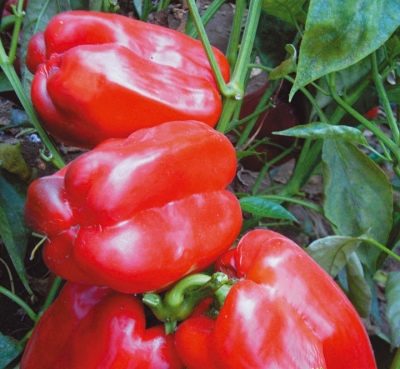
- Bush height, cm: 50
- Growth type: medium-sized
- Fruit shape: cuboid
- Fruit weight, g: 200
- Fruit color: green and red
- Ripening terms: mid-season
- Appointment: for fresh consumption, for canning
- Growing conditions: greenhouse, open ground
- Fruit size: large
- Fruit wall thickness, mm: 7-8
The Bon Appetit hybrid variety cannot boast of an outstanding yield, but it allows the gardener to pick a dozen medium-sized sweet fruits from the bushes annually. The seeds of the variety have been on the market since 2014, but they are still not included in the State Register. The breeder of this variety is also unknown.
Description of the variety
A hybrid of sweet peppers called Bon Appetit is distinguished by its versatility in cultivation, and therefore can be bred both outdoors and under a film shelter or in a greenhouse. The variety is characterized by good immunity that protects the crop from most common diseases. The culture is characterized by a female type of flowering.
Characteristics of the appearance of plants and fruits
Bushes of the Bon Appetit variety grow medium-sized, but powerful. Strong shoots are covered with small green leaves. Their height does not exceed a meter, stopping at the level of 50-70 centimeters. The color of the fruit changes from technical green to almost ruby upon reaching biological ripeness. The mass of one very large pepper, elongated cuboid, varies from 150 to 200 grams.
The length of the vegetable does not go beyond the boundaries of 12-14 centimeters, and the diameter can reach 9-12 centimeters. There are several visible ribs on the glossy surface, and there are 4 chambers inside the fruit. The wall thickness ranges from 7 to 8 millimeters.
Purpose and taste
The fleshy, juicy pulp of the Bon Appetite bell peppers is characterized by a sugary taste without the slightest bitterness and a fragrant aroma. Vegetables are consumed fresh, used to prepare a variety of hot dishes and sauces, and are also used in preparations. It is generally accepted that the sweet taste of a vegetable appears already at the stage of technical ripeness.
Ripening terms
The Bon Appetite pepper variety is usually referred to as mid-season. After sprouting, it usually takes 118-120 days to harvest the first crop. The ripening period usually lasts from July to September.
Yield
The Bon Appetite pepper variety is not very fruitful, allowing the gardener to remove only 1 to 2 kilograms of fruit from each bush per season, which is approximately equivalent to 10-12 jokes.

To get a large and tasty harvest of pepper, you need to take care of the seedlings in advance. When growing pepper seedlings, you need to correctly determine the sowing time, pre-sowing seed treatment, prepare the necessary container and soil.
Growing and care
Sowing seeds for seedlings starts in the second half of February or the first week of March. The seeds are immediately distributed into individual pots to avoid picking in the future. The containers, if necessary, are additionally illuminated, and their contents are irrigated from a spray bottle or syringe. Until the material germinates, it will need to be kept at a temperature of +25 - +28 degrees, and then these boundaries will have to be reduced to +20 - +23 degrees. It usually takes about 10 days for seedlings to emerge.
Disembarkation is carried out when the bushes reach a height of 18-23 centimeters. As a rule, this is carried out in the second May decade.The ground for peppers is loose, soft and light, and the bed itself should be well lit. Seedlings should be distributed on the ground in such a way that a gap of 30-50 centimeters remains between individual specimens. In fact, this means that there will be no more than 3-4 peppers on each square meter.
In order for the representatives of the Bon Appetit variety to develop well, they will need regular feeding. After 10-14 days after transfer to the ground, it will be necessary to use urea, superphosphate, Agricola or Clean sheet. During mass flowering, the crop will need wood ash, superphosphate and Novofert. Finally, when the fruits begin to ripen, you will have to apply potassium-phosphorus fertilizers: potassium sulfate, "Humisol", "Ideal" or "Strela".
It is customary to form peppers into 2 trunks by pinching all the shoots below the fork. Plants should be watered abundantly, 2 times a week, adjusting this frequency according to weather conditions. The soil in the garden is also necessarily loosened and mulched with appropriate materials.

To harvest a tasty and rich harvest of pepper, you need to comply with all the conditions of agricultural technology, and proper care begins with planting plants. Before planting pepper in open ground, it should be prepared. It is also important to take care of the seedlings and planting space in advance.




For good growth of pepper bushes and active fruiting, you need to regularly apply mineral and organic fertilizing to the soil. It is necessary not only to choose the right formulations, but also to use them at the right stage in the development of culture. The frequency of top dressing is always individual. It depends directly on the composition of the land on your site. The poorer the soil composition, the more often you will need to feed the pepper.

Pepper is one of the most common vegetables in home gardens. This culture is quite stable and unpretentious. However, under certain conditions, this plant can suffer from infections and harmful insects. Before treating peppers for diseases or pests, you need to find out the cause of the problem, otherwise the treatment may be ineffective.





















































































